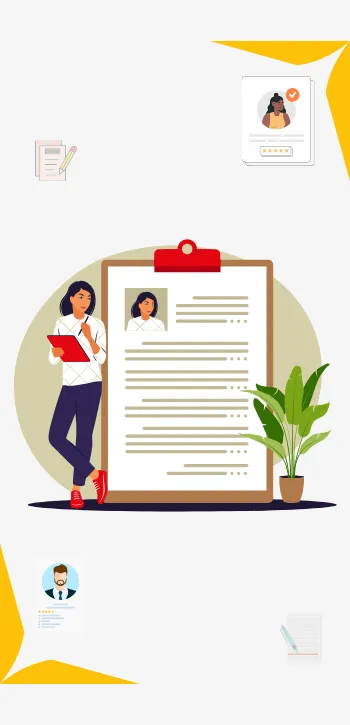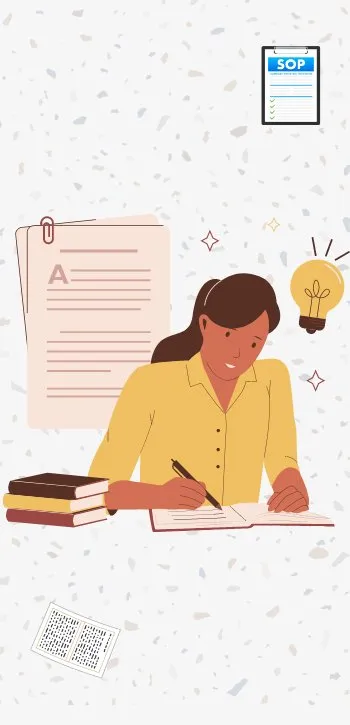- Start the Australian student visa (Subclass 500) process at least 3 months before your course begins. Show proof of ~AUD 29,710 for one year’s living costs plus tuition and travel.
- In 2025, applicants must respond to structured questions instead of writing a GTE statement, proving their academic intent, financial readiness, and career goals.
- Overseas Student Health Cover (OSHC) is mandatory for visa approval. You can bring family, but you must provide extra financial and documentation support for them.
- Application Timeline for Australian Study Visa (Subclass 500 Student Visa)
-
Australian Study Visa Document Checklist for 2025
- Personal Identification
- Proof of Enrolment in an Australian University
- Academic Background
- Financial Capability
- Affidavit of Financial Support
- Health Insurance
- Travel Information
- Character Requirements
- Visa Application Documents
- English Language Proficiency
- Genuine Student (GS) Requirement
- Student Visa Declaration
- Key Takeaways by AdmitX
- FAQs
Australia is a preferred destination for international students pursuing higher education. To study at an Australian institution, students must first obtain a valid Australian visa. This visa not only allows them to study for the duration of their course but also offers the benefit of part-time work and other opportunities.
Before applying for a student visa for Australia, it’s important to gain a comprehensive understanding of the process, including timelines, required documents, financial requirements, and other key details. This blog provides a complete guide to the Australian study visa document checklist.
Application Timeline for Australian Study Visa (Subclass 500 Student Visa)
12–10 Months Before Course Start Date
- Begin exploring Australian universities and their course offerings.
- Understand entry requirements, tuition fees, and application deadlines.
- Prepare for standardized English proficiency tests like IELTS, TOEFL, or PTE if needed.
- Start estimating total expenses, including tuition, living costs, travel, and insurance.
10–8 Months Before Course Start Date
- Submit applications to selected universities.
- Include academic transcripts, test scores, a Statement of Purpose (SOP), Letters of Recommendation (LORs), and a resume.
- Wait for offer letters, which may take between 2 and 8 weeks.
8–6 Months Before Course Start Date
- Accept your university offer by paying the required deposit.
- Once confirmed, the university will issue your Confirmation of Enrolment (CoE), a vital document needed for your visa application.
6–5 Months Before Course Start Date
Begin collecting documents for your visa. Ensure you have
- A passport valid for 6+ months beyond your stay
- Recent passport-sized photographs
- Confirmation of Enrolment (CoE)
- Academic qualifications and certificates
- English language test scores
- Proof of funds (bank statements, income proof, sponsor details if applicable)
- Overseas Student Health Cover (OSHC) receipt
- Police Clearance Certificate (PCC)
- Affidavit of financial support (if sponsored)
5–4 Months Before Course Start Date
- Create an ImmiAccount on the Australian immigration portal.
- Fill out the Subclass 500 visa application, upload your documents, and pay the application fee (AUD 710).
- Review your submission carefully for accuracy.
4–2 Months Before Course Start Date
- You may be invited to provide biometrics at a visa application centre.
- In some cases, attend an interview.
- If immigration requires additional documents, submit them promptly to avoid delays.
2–1 Month Before Course Start Date
- Visa decisions typically take 4 to 8 weeks.
- Once granted, begin booking your airline tickets.
- Make copies of all key documents, including your visa grant, CoE, OSHC, and university offer.
Final Month Before Departure
- Attend any pre-departure sessions offered by your university or agency.
- Pack essentials according to the Australian climate and rules.
- Arrange temporary accommodation if needed. Familiarize yourself with visa conditions and Australian laws for international students.
Australian Study Visa Document Checklist for 2025
To ensure a seamless application process for your Australian study visa, collect all the necessary documents well in advance. According to the Australian Government’s Department of Immigration and Citizenship, it is advisable to begin gathering these documents at least 90 days prior to submitting your application. This provides enough time to secure all essential paperwork.
Personal Identification
- Valid Passport: To be granted entry, your passport must have a validity of at least 6 months beyond your planned duration in Australia.
- Passport-sized Photographs: Two recent passport-sized photographs (51mm x 51mm) meet the specified requirements.
Proof of Enrolment in an Australian University
- Confirmation of Enrolment (CoE): The official document issued by your university confirming your enrolment in the specific course.
- Registration Letter: The registration letter you received from the Australian university you applied to.
Academic Background
Academic Transcripts: Photocopies of all your academic diplomas, bachelor’s degree, certificates, and other credentials relevant to your intended studies in Australia, including your degree certificate.
Financial Capability
Proof of Funds: You must display the total amount in your account for the first year’s tuition fees and living costs for one year at the university to which you have been selected.
- To study in Australia, you must demonstrate a bank balance of AUD 29,710 (INR 16 Lakh) for living expenses for 1 year.
- Minimum 3-month-old bank balance certificate and statements with evidence of income.
- Documents that verify income sources for the student and the sponsor (if any).
- Copy of scholarship letter.
Acceptable Evidence of Funds
Here’s what you can provide as evidence
- Money Deposits: Bank statements showing funds in a reputable financial institution are acceptable. Term deposits may also be considered if you have unrestricted access to the funds during your visa period.
- Loans: A legally binding loan from a recognised financial institution is acceptable. This includes lines of credit and credit cards with a pre-approved limit.
- Government Loans or Scholarships: Official documentation confirming financial support from a government agency, educational institution, or international organisation is required.
Unacceptable Evidence
- The value of property you own cannot be used as evidence.
- Funds held in non-approved financial institutions, such as post office accounts, are not acceptable unless transferred to a recognised institution.
Financial Institutions
- The financial institution must be
- Licensed by the country’s central bank.
- Implement sound credit risk management practices.
- Hold a high credit rating from an independent body.
- Have a history of providing legitimate financial evidence to Australian immigration.
Family Members
- If family members are joining you, they must demonstrate their own financial capacity to meet living expenses.
Affidavit of Financial Support
If relying on a sponsor’s funds, they will need to provide an affidavit declaring the available funds cover your tuition fees, accommodation, living expenses, health insurance, and return airfare.
Health Insurance
Overseas Student Health Cover (OSHC): A valid OSHC receipt confirming your health insurance coverage is a minimum of AUD 478 for 1 year for your stay in Australia.
Travel Information
Airline Ticket: If your study program in Australia exceeds six months, a copy of your one-way airline ticket might be requested.
Character Requirements
Police Clearance Certificate: A certificate of no criminal history obtained from your country.
Visa Application Documents
- Visa Application Form (Subclass 500): This is a long-stay application form for over 90 days. It is the completed online application form for a Subclass 500 student visa.
- Application Fee Payment Receipt: Proof of payment for the mandatory student visa application fee, which is AUD 710 or INR 38,000.
English Language Proficiency
English Language Test Scorecard: A copy of your IELTS (minimum 6.0 overall), TOEFL (minimum 46), or PTE (minimum 42) scorecard if you are from a non-English speaking nation.
Genuine Student (GS) Requirement
The Australian government has introduced the Genuine Student (GS) requirement to streamline the student visa application process and enhance its effectiveness. GS has also replaced GTE (Genuine Temporary Entrant). Here’s why GS requirements have replaced GTE
What Information Does the GS Requirement Gather?
The GS questions delve into various aspects of your background and study plans.
- Current Circumstances: You’ll provide details about your current situation, including family ties, community involvement, employment status, and financial circumstances. These details establish your connection to your home country.
- Course and Destination Choice: Explain your rationale for choosing your specific course and why Australia is your preferred study destination.
- Anticipated Benefits: Outline how studying your chosen course will benefit you academically and professionally.
- Prior Study Experience in Australia: If you have any previous study experience in Australia, provide details about it.
- Visa Type Change: If you currently hold a visa other than a student visa, explain your reasons for applying for a student visa.
- Additional Information: You have the opportunity to share any further relevant information that strengthens your application.
Student Visa Declaration
By signing the statement, you confirm that
- You understand the meaning of being a genuine student.
- You have read, comprehended, and agreed to abide by all student visa conditions and notify the Department of Home Affairs of any changes in your circumstances.
- You are aware that while pathways to permanent residency exist after your studies, only a limited number of graduates qualify.
Key Takeaways by AdmitX
By adhering to the steps outlined in this detailed guide, you’ll ensure a smooth Australian student visa application experience. Timely submission remains crucial. The starting point of your academic adventure in Australia is choosing the right course and university, which forms the core of your visa process.
Take the time to explore your choices thoroughly, align them with your aspirations, and prepare to embark on a fulfilling educational journey in Australia.
FAQs
How long does it take to get an Australian student visa in 2025?
In 2025, the processing time for the Subclass 500 student visa generally ranges between 4 to 8 weeks, though this can vary depending on the applicant’s profile, the volume of applications received, and how quickly additional information is provided if requested.
It’s recommended that students start their visa preparation at least 90 days before their course begins.
What financial proof is required for an Australian student visa in 2025?
To secure an Australian student visa in 2025, international students must demonstrate that they can financially support themselves during their studies.
This includes showing access to a minimum of AUD 29,710 (approximately INR 16 lakh) for one year’s living expenses, in addition to tuition fees and travel costs. Funds must be in a recognised bank account for at least 3 months before application.
Is health insurance mandatory for student visa holders in Australia?
Yes, international students must purchase Overseas Student Health Cover (OSHC) before arriving in Australia. This health insurance is mandatory and provides access to medical care while living and studying in Australia.
For 2025, the minimum OSHC cost for a single student is around AUD 478 for one year. Without proof of OSHC, the visa application will not be approved.
What is the GS (Genuine Student) requirement, and how does it impact my visa for Australia?
In 2025, the Genuine Student (GS) requirement replaced the earlier GTE (Genuine Temporary Entrant) statement. Instead of a 300-word written declaration, the visa process now includes a set of structured questions aimed at understanding your intent to study.
You’ll need to explain your current circumstances, reasons for choosing Australia, and your course, career goals, financial readiness, and any past visa or travel history.
Can I bring my family with me while studying in Australia?
Yes, students applying for an Australian student visa can include eligible family members (spouse/partner and dependent children) as secondary applicants in their visa application.
However, you must show additional financial proof to cover their living expenses during the intended period of stay. For each family member, you need to demonstrate the required funds for living costs, accommodation, and travel.
Check out Other Blogs















